Applied Business Finance: Reviewing and Improving Performance
VerifiedAdded on 2023/06/18
|14
|2675
|268
Report
AI Summary
This report provides an analysis of applied business finance, emphasizing the importance of financial management and the role of financial statements in evaluating a company's financial health. It covers key financial statements such as the income statement, balance sheet, and cash flow statement, along with the application of various financial ratios like liquidity, profitability, efficiency, and solvency ratios. The report includes a business performance review based on ratio analysis, interpreting the company's current and quick ratios, gross and net profit ratios, inventory turnover, and fixed asset turnover. It suggests ways to improve financial performance, focusing on marketing strategies, credit policy, pricing, and liquidity management. The conclusion summarizes the overall financial health of the company and highlights areas for further improvement, emphasizing the need for continuous focus on profitability and financial stability. Desklib provides students access to this document and many more solved assignments.

APPLIED BUSINESS FINANCE
1
1
Paraphrase This Document
Need a fresh take? Get an instant paraphrase of this document with our AI Paraphraser
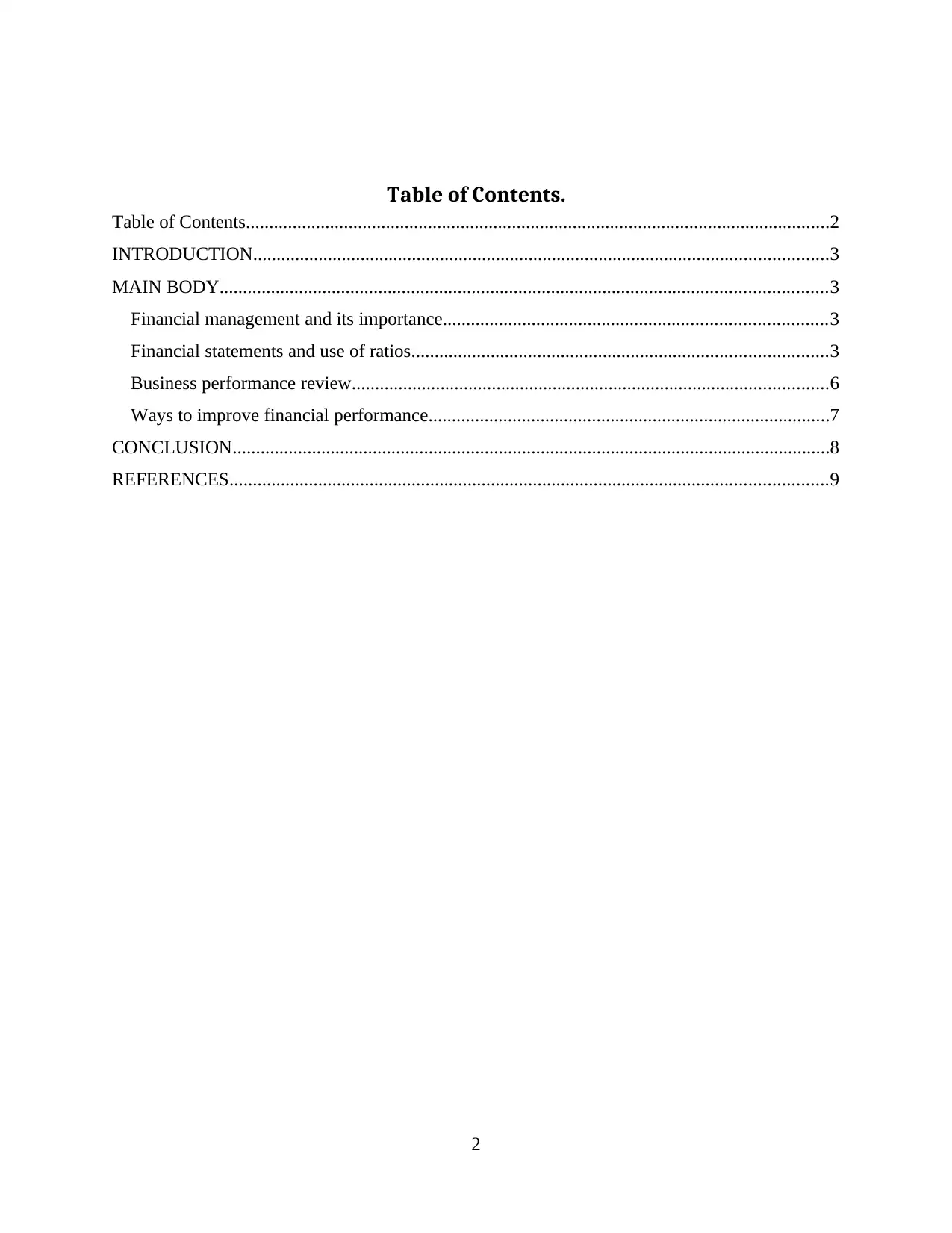
Table of Contents.
Table of Contents.............................................................................................................................2
INTRODUCTION...........................................................................................................................3
MAIN BODY..................................................................................................................................3
Financial management and its importance..................................................................................3
Financial statements and use of ratios.........................................................................................3
Business performance review......................................................................................................6
Ways to improve financial performance......................................................................................7
CONCLUSION................................................................................................................................8
REFERENCES................................................................................................................................9
2
Table of Contents.............................................................................................................................2
INTRODUCTION...........................................................................................................................3
MAIN BODY..................................................................................................................................3
Financial management and its importance..................................................................................3
Financial statements and use of ratios.........................................................................................3
Business performance review......................................................................................................6
Ways to improve financial performance......................................................................................7
CONCLUSION................................................................................................................................8
REFERENCES................................................................................................................................9
2
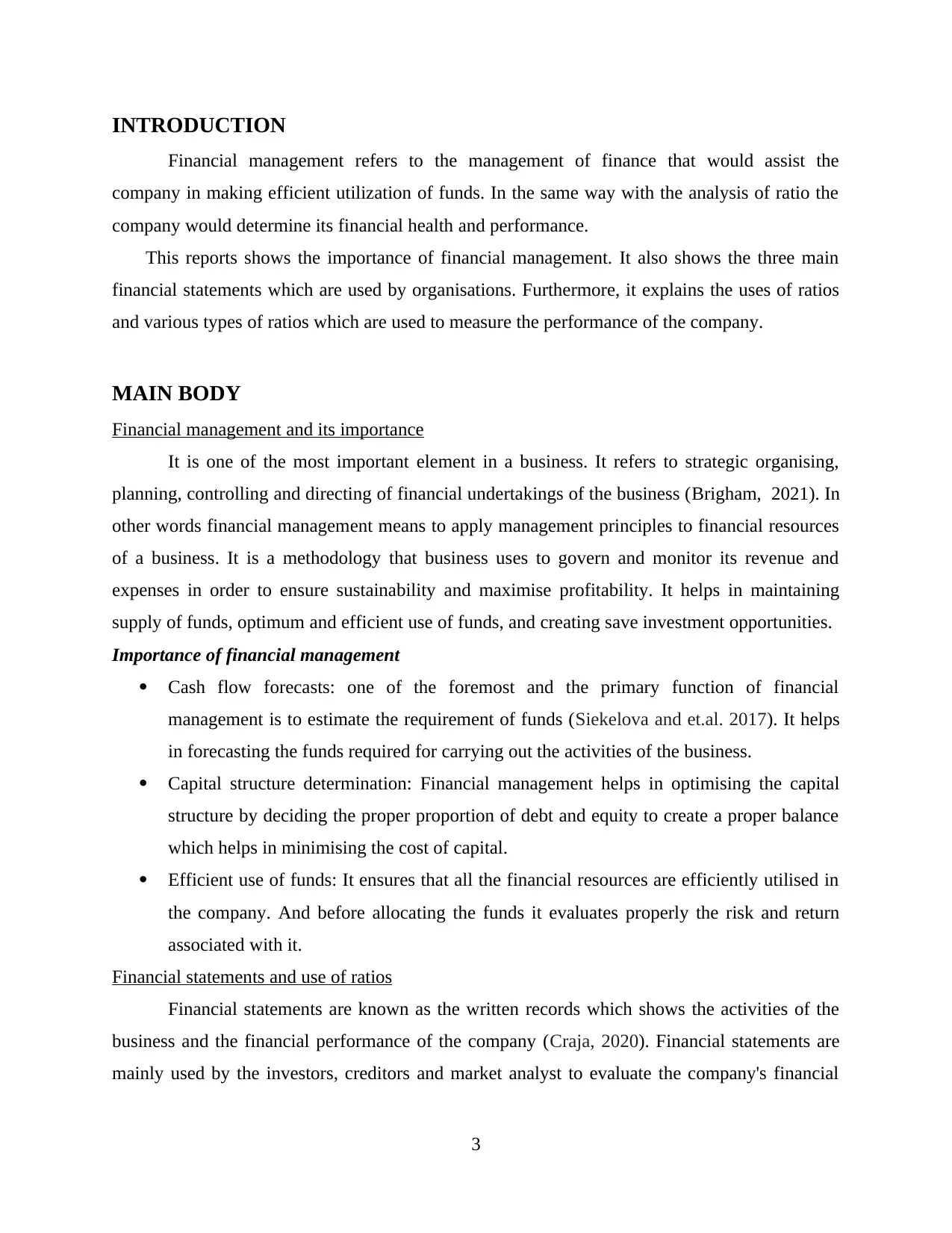
INTRODUCTION
Financial management refers to the management of finance that would assist the
company in making efficient utilization of funds. In the same way with the analysis of ratio the
company would determine its financial health and performance.
This reports shows the importance of financial management. It also shows the three main
financial statements which are used by organisations. Furthermore, it explains the uses of ratios
and various types of ratios which are used to measure the performance of the company.
MAIN BODY
Financial management and its importance
It is one of the most important element in a business. It refers to strategic organising,
planning, controlling and directing of financial undertakings of the business (Brigham, 2021). In
other words financial management means to apply management principles to financial resources
of a business. It is a methodology that business uses to govern and monitor its revenue and
expenses in order to ensure sustainability and maximise profitability. It helps in maintaining
supply of funds, optimum and efficient use of funds, and creating save investment opportunities.
Importance of financial management
Cash flow forecasts: one of the foremost and the primary function of financial
management is to estimate the requirement of funds (Siekelova and et.al. 2017). It helps
in forecasting the funds required for carrying out the activities of the business.
Capital structure determination: Financial management helps in optimising the capital
structure by deciding the proper proportion of debt and equity to create a proper balance
which helps in minimising the cost of capital.
Efficient use of funds: It ensures that all the financial resources are efficiently utilised in
the company. And before allocating the funds it evaluates properly the risk and return
associated with it.
Financial statements and use of ratios
Financial statements are known as the written records which shows the activities of the
business and the financial performance of the company (Craja, 2020). Financial statements are
mainly used by the investors, creditors and market analyst to evaluate the company's financial
3
Financial management refers to the management of finance that would assist the
company in making efficient utilization of funds. In the same way with the analysis of ratio the
company would determine its financial health and performance.
This reports shows the importance of financial management. It also shows the three main
financial statements which are used by organisations. Furthermore, it explains the uses of ratios
and various types of ratios which are used to measure the performance of the company.
MAIN BODY
Financial management and its importance
It is one of the most important element in a business. It refers to strategic organising,
planning, controlling and directing of financial undertakings of the business (Brigham, 2021). In
other words financial management means to apply management principles to financial resources
of a business. It is a methodology that business uses to govern and monitor its revenue and
expenses in order to ensure sustainability and maximise profitability. It helps in maintaining
supply of funds, optimum and efficient use of funds, and creating save investment opportunities.
Importance of financial management
Cash flow forecasts: one of the foremost and the primary function of financial
management is to estimate the requirement of funds (Siekelova and et.al. 2017). It helps
in forecasting the funds required for carrying out the activities of the business.
Capital structure determination: Financial management helps in optimising the capital
structure by deciding the proper proportion of debt and equity to create a proper balance
which helps in minimising the cost of capital.
Efficient use of funds: It ensures that all the financial resources are efficiently utilised in
the company. And before allocating the funds it evaluates properly the risk and return
associated with it.
Financial statements and use of ratios
Financial statements are known as the written records which shows the activities of the
business and the financial performance of the company (Craja, 2020). Financial statements are
mainly used by the investors, creditors and market analyst to evaluate the company's financial
3
⊘ This is a preview!⊘
Do you want full access?
Subscribe today to unlock all pages.

Trusted by 1+ million students worldwide
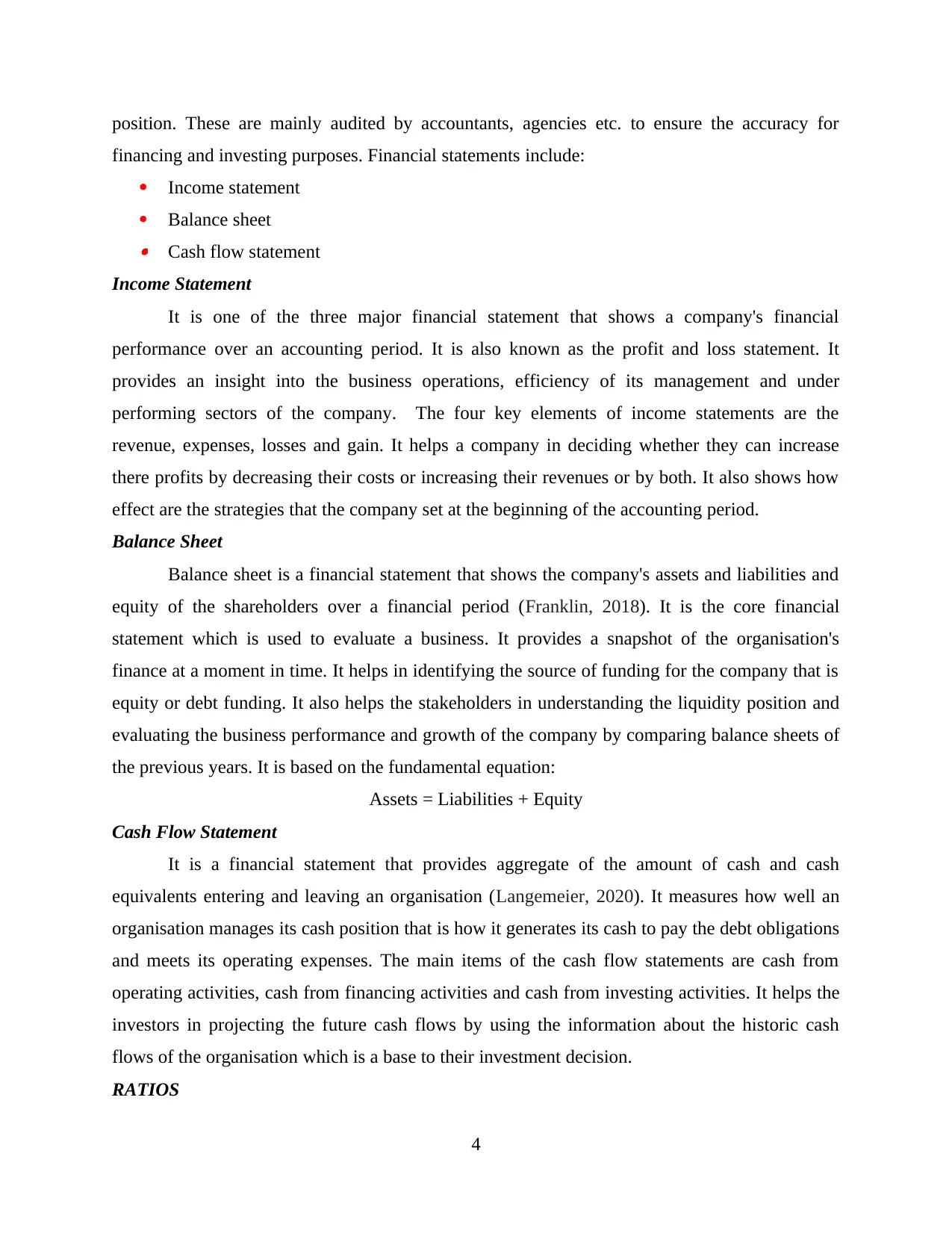
position. These are mainly audited by accountants, agencies etc. to ensure the accuracy for
financing and investing purposes. Financial statements include:
Income statement
Balance sheet Cash flow statement
Income Statement
It is one of the three major financial statement that shows a company's financial
performance over an accounting period. It is also known as the profit and loss statement. It
provides an insight into the business operations, efficiency of its management and under
performing sectors of the company. The four key elements of income statements are the
revenue, expenses, losses and gain. It helps a company in deciding whether they can increase
there profits by decreasing their costs or increasing their revenues or by both. It also shows how
effect are the strategies that the company set at the beginning of the accounting period.
Balance Sheet
Balance sheet is a financial statement that shows the company's assets and liabilities and
equity of the shareholders over a financial period (Franklin, 2018). It is the core financial
statement which is used to evaluate a business. It provides a snapshot of the organisation's
finance at a moment in time. It helps in identifying the source of funding for the company that is
equity or debt funding. It also helps the stakeholders in understanding the liquidity position and
evaluating the business performance and growth of the company by comparing balance sheets of
the previous years. It is based on the fundamental equation:
Assets = Liabilities + Equity
Cash Flow Statement
It is a financial statement that provides aggregate of the amount of cash and cash
equivalents entering and leaving an organisation (Langemeier, 2020). It measures how well an
organisation manages its cash position that is how it generates its cash to pay the debt obligations
and meets its operating expenses. The main items of the cash flow statements are cash from
operating activities, cash from financing activities and cash from investing activities. It helps the
investors in projecting the future cash flows by using the information about the historic cash
flows of the organisation which is a base to their investment decision.
RATIOS
4
financing and investing purposes. Financial statements include:
Income statement
Balance sheet Cash flow statement
Income Statement
It is one of the three major financial statement that shows a company's financial
performance over an accounting period. It is also known as the profit and loss statement. It
provides an insight into the business operations, efficiency of its management and under
performing sectors of the company. The four key elements of income statements are the
revenue, expenses, losses and gain. It helps a company in deciding whether they can increase
there profits by decreasing their costs or increasing their revenues or by both. It also shows how
effect are the strategies that the company set at the beginning of the accounting period.
Balance Sheet
Balance sheet is a financial statement that shows the company's assets and liabilities and
equity of the shareholders over a financial period (Franklin, 2018). It is the core financial
statement which is used to evaluate a business. It provides a snapshot of the organisation's
finance at a moment in time. It helps in identifying the source of funding for the company that is
equity or debt funding. It also helps the stakeholders in understanding the liquidity position and
evaluating the business performance and growth of the company by comparing balance sheets of
the previous years. It is based on the fundamental equation:
Assets = Liabilities + Equity
Cash Flow Statement
It is a financial statement that provides aggregate of the amount of cash and cash
equivalents entering and leaving an organisation (Langemeier, 2020). It measures how well an
organisation manages its cash position that is how it generates its cash to pay the debt obligations
and meets its operating expenses. The main items of the cash flow statements are cash from
operating activities, cash from financing activities and cash from investing activities. It helps the
investors in projecting the future cash flows by using the information about the historic cash
flows of the organisation which is a base to their investment decision.
RATIOS
4
Paraphrase This Document
Need a fresh take? Get an instant paraphrase of this document with our AI Paraphraser
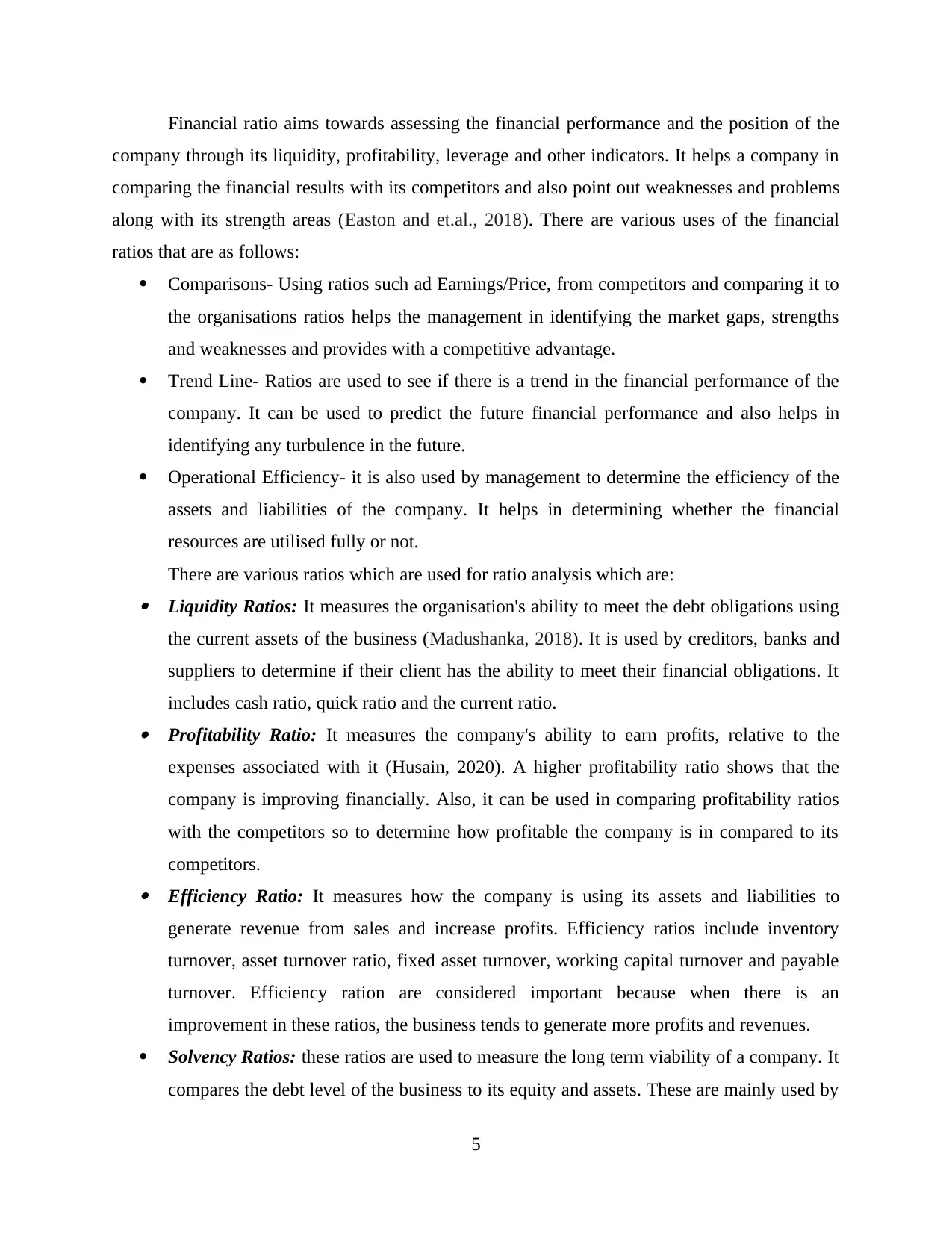
Financial ratio aims towards assessing the financial performance and the position of the
company through its liquidity, profitability, leverage and other indicators. It helps a company in
comparing the financial results with its competitors and also point out weaknesses and problems
along with its strength areas (Easton and et.al., 2018). There are various uses of the financial
ratios that are as follows:
Comparisons- Using ratios such ad Earnings/Price, from competitors and comparing it to
the organisations ratios helps the management in identifying the market gaps, strengths
and weaknesses and provides with a competitive advantage.
Trend Line- Ratios are used to see if there is a trend in the financial performance of the
company. It can be used to predict the future financial performance and also helps in
identifying any turbulence in the future.
Operational Efficiency- it is also used by management to determine the efficiency of the
assets and liabilities of the company. It helps in determining whether the financial
resources are utilised fully or not.
There are various ratios which are used for ratio analysis which are: Liquidity Ratios: It measures the organisation's ability to meet the debt obligations using
the current assets of the business (Madushanka, 2018). It is used by creditors, banks and
suppliers to determine if their client has the ability to meet their financial obligations. It
includes cash ratio, quick ratio and the current ratio. Profitability Ratio: It measures the company's ability to earn profits, relative to the
expenses associated with it (Husain, 2020). A higher profitability ratio shows that the
company is improving financially. Also, it can be used in comparing profitability ratios
with the competitors so to determine how profitable the company is in compared to its
competitors. Efficiency Ratio: It measures how the company is using its assets and liabilities to
generate revenue from sales and increase profits. Efficiency ratios include inventory
turnover, asset turnover ratio, fixed asset turnover, working capital turnover and payable
turnover. Efficiency ration are considered important because when there is an
improvement in these ratios, the business tends to generate more profits and revenues.
Solvency Ratios: these ratios are used to measure the long term viability of a company. It
compares the debt level of the business to its equity and assets. These are mainly used by
5
company through its liquidity, profitability, leverage and other indicators. It helps a company in
comparing the financial results with its competitors and also point out weaknesses and problems
along with its strength areas (Easton and et.al., 2018). There are various uses of the financial
ratios that are as follows:
Comparisons- Using ratios such ad Earnings/Price, from competitors and comparing it to
the organisations ratios helps the management in identifying the market gaps, strengths
and weaknesses and provides with a competitive advantage.
Trend Line- Ratios are used to see if there is a trend in the financial performance of the
company. It can be used to predict the future financial performance and also helps in
identifying any turbulence in the future.
Operational Efficiency- it is also used by management to determine the efficiency of the
assets and liabilities of the company. It helps in determining whether the financial
resources are utilised fully or not.
There are various ratios which are used for ratio analysis which are: Liquidity Ratios: It measures the organisation's ability to meet the debt obligations using
the current assets of the business (Madushanka, 2018). It is used by creditors, banks and
suppliers to determine if their client has the ability to meet their financial obligations. It
includes cash ratio, quick ratio and the current ratio. Profitability Ratio: It measures the company's ability to earn profits, relative to the
expenses associated with it (Husain, 2020). A higher profitability ratio shows that the
company is improving financially. Also, it can be used in comparing profitability ratios
with the competitors so to determine how profitable the company is in compared to its
competitors. Efficiency Ratio: It measures how the company is using its assets and liabilities to
generate revenue from sales and increase profits. Efficiency ratios include inventory
turnover, asset turnover ratio, fixed asset turnover, working capital turnover and payable
turnover. Efficiency ration are considered important because when there is an
improvement in these ratios, the business tends to generate more profits and revenues.
Solvency Ratios: these ratios are used to measure the long term viability of a company. It
compares the debt level of the business to its equity and assets. These are mainly used by
5
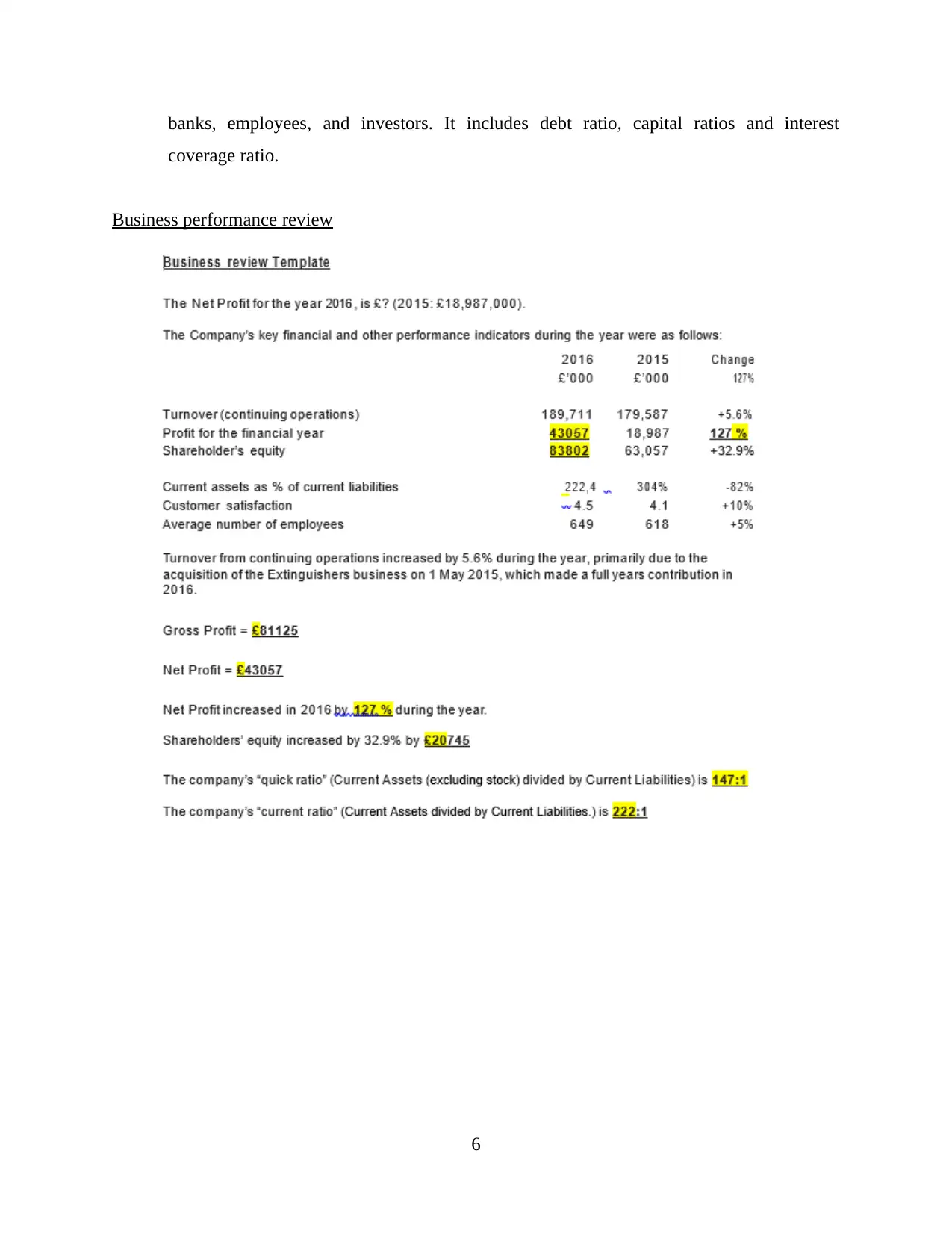
banks, employees, and investors. It includes debt ratio, capital ratios and interest
coverage ratio.
Business performance review
6
coverage ratio.
Business performance review
6
⊘ This is a preview!⊘
Do you want full access?
Subscribe today to unlock all pages.

Trusted by 1+ million students worldwide
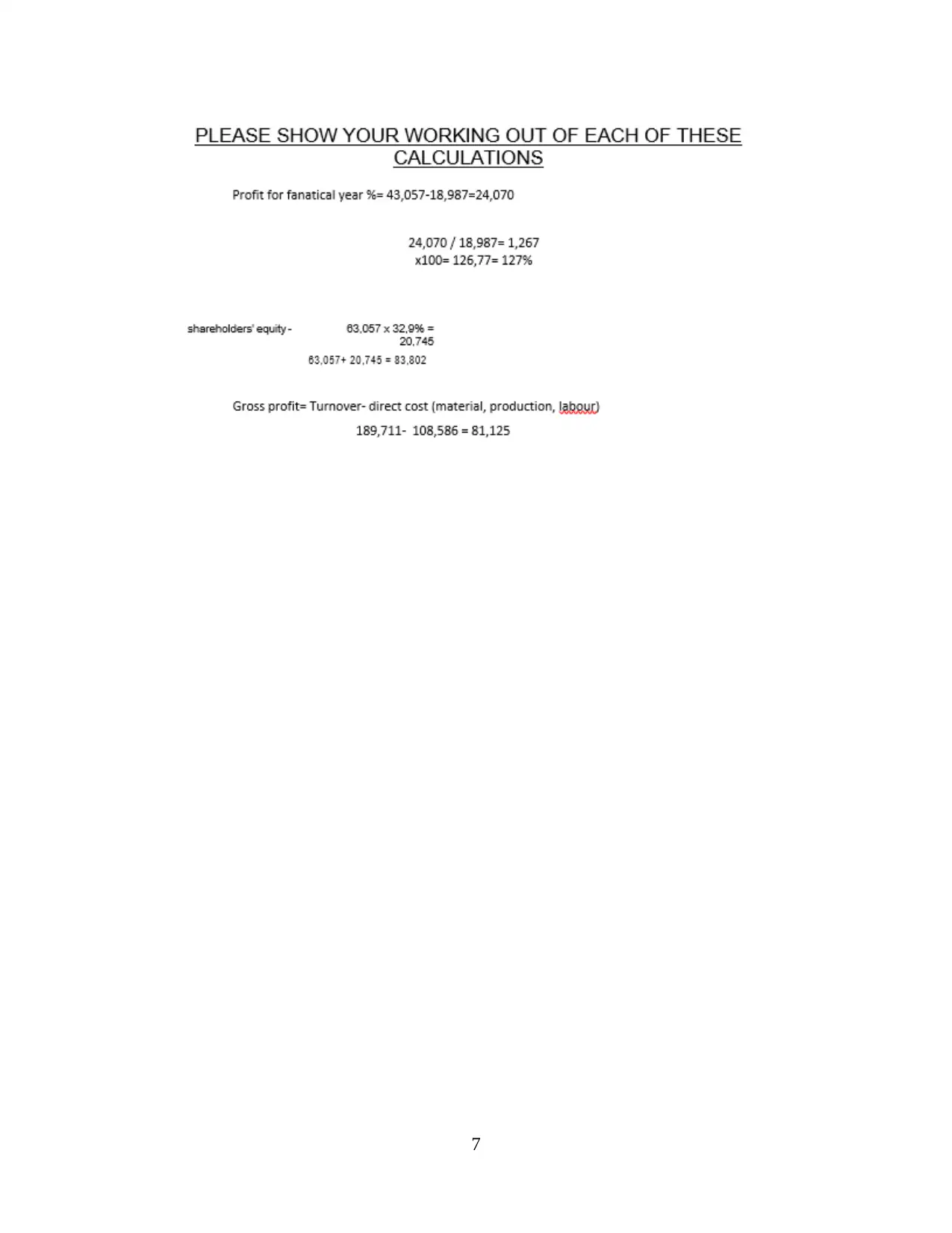
7
Paraphrase This Document
Need a fresh take? Get an instant paraphrase of this document with our AI Paraphraser
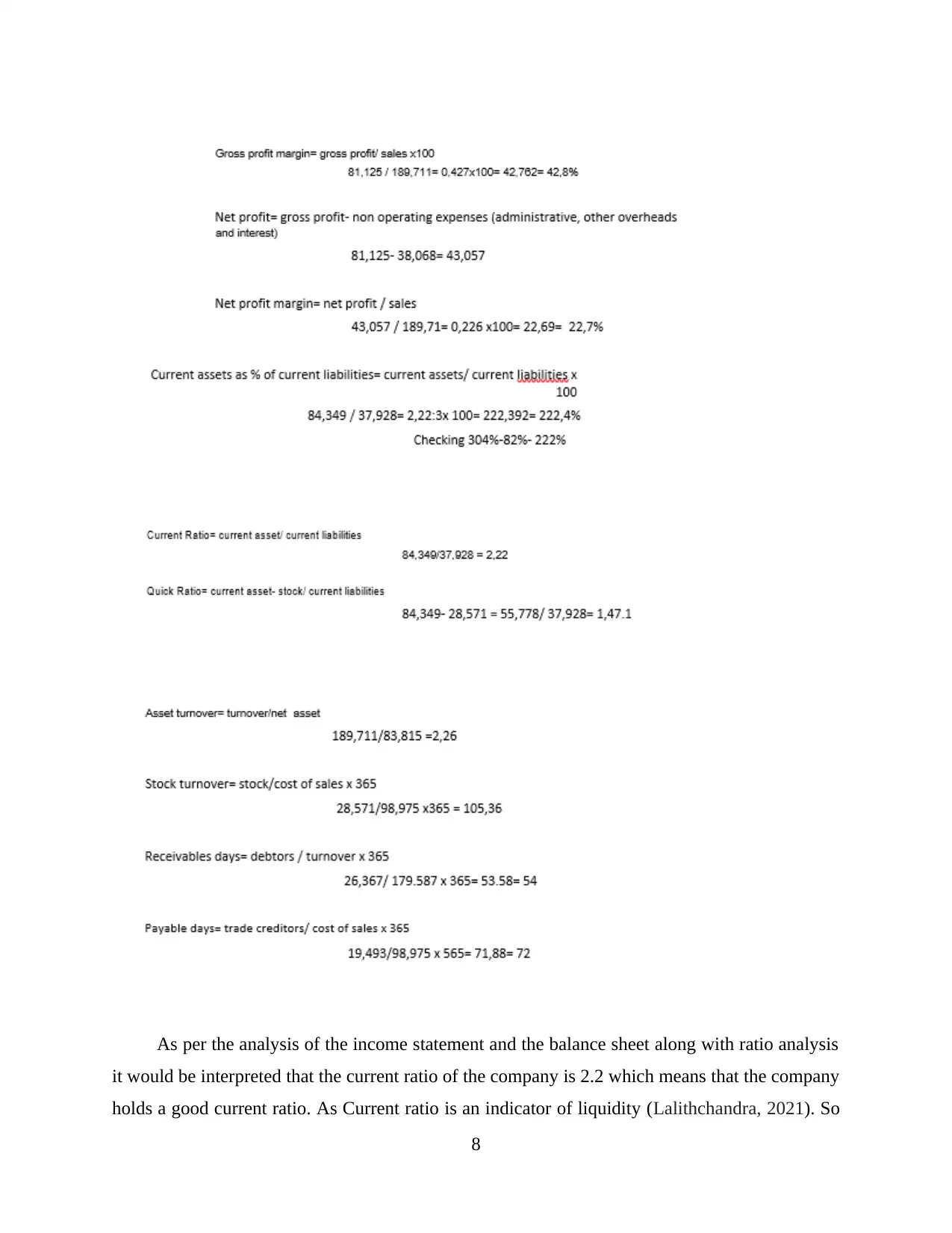
As per the analysis of the income statement and the balance sheet along with ratio analysis
it would be interpreted that the current ratio of the company is 2.2 which means that the company
holds a good current ratio. As Current ratio is an indicator of liquidity (Lalithchandra, 2021). So
8
it would be interpreted that the current ratio of the company is 2.2 which means that the company
holds a good current ratio. As Current ratio is an indicator of liquidity (Lalithchandra, 2021). So
8
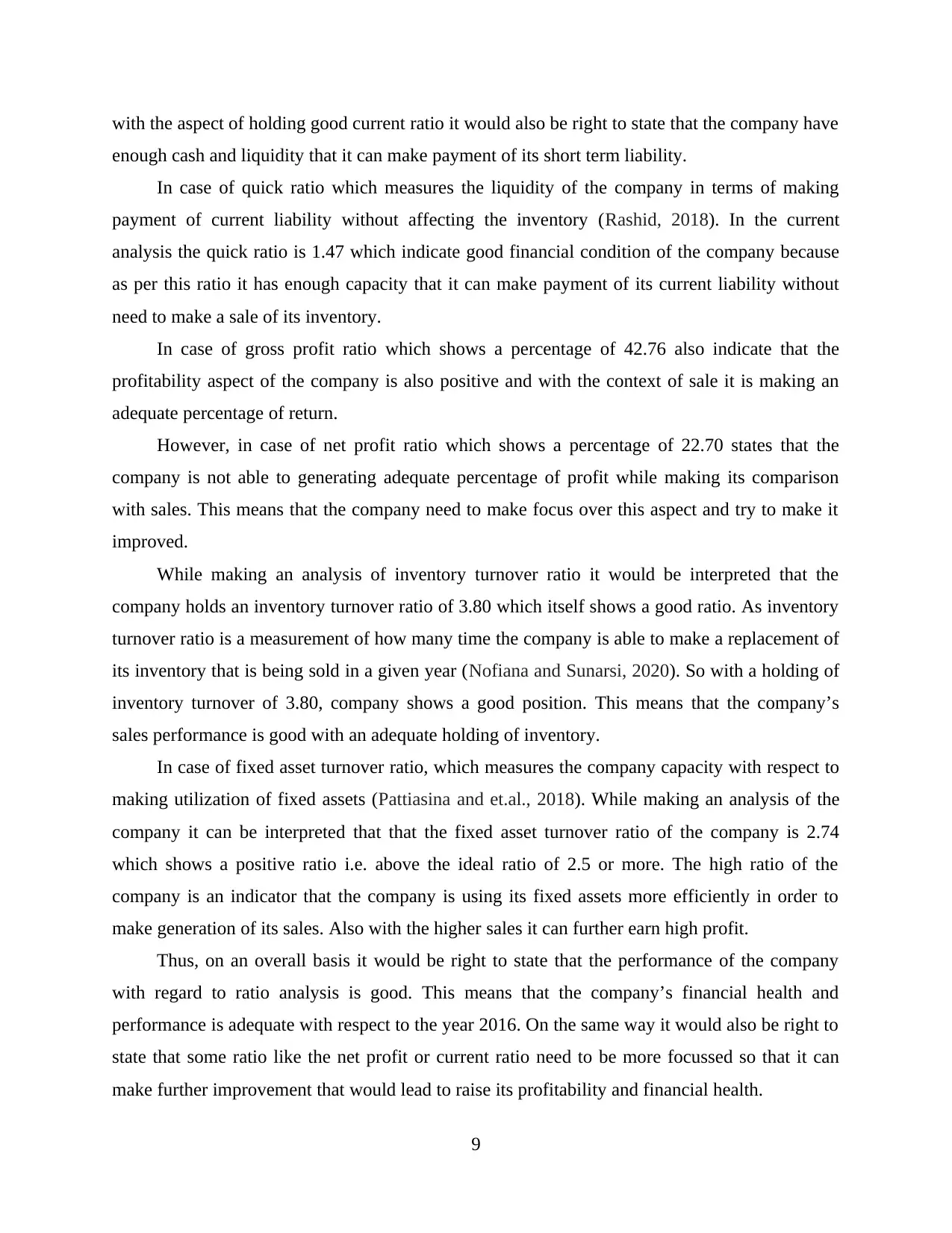
with the aspect of holding good current ratio it would also be right to state that the company have
enough cash and liquidity that it can make payment of its short term liability.
In case of quick ratio which measures the liquidity of the company in terms of making
payment of current liability without affecting the inventory (Rashid, 2018). In the current
analysis the quick ratio is 1.47 which indicate good financial condition of the company because
as per this ratio it has enough capacity that it can make payment of its current liability without
need to make a sale of its inventory.
In case of gross profit ratio which shows a percentage of 42.76 also indicate that the
profitability aspect of the company is also positive and with the context of sale it is making an
adequate percentage of return.
However, in case of net profit ratio which shows a percentage of 22.70 states that the
company is not able to generating adequate percentage of profit while making its comparison
with sales. This means that the company need to make focus over this aspect and try to make it
improved.
While making an analysis of inventory turnover ratio it would be interpreted that the
company holds an inventory turnover ratio of 3.80 which itself shows a good ratio. As inventory
turnover ratio is a measurement of how many time the company is able to make a replacement of
its inventory that is being sold in a given year (Nofiana and Sunarsi, 2020). So with a holding of
inventory turnover of 3.80, company shows a good position. This means that the company’s
sales performance is good with an adequate holding of inventory.
In case of fixed asset turnover ratio, which measures the company capacity with respect to
making utilization of fixed assets (Pattiasina and et.al., 2018). While making an analysis of the
company it can be interpreted that that the fixed asset turnover ratio of the company is 2.74
which shows a positive ratio i.e. above the ideal ratio of 2.5 or more. The high ratio of the
company is an indicator that the company is using its fixed assets more efficiently in order to
make generation of its sales. Also with the higher sales it can further earn high profit.
Thus, on an overall basis it would be right to state that the performance of the company
with regard to ratio analysis is good. This means that the company’s financial health and
performance is adequate with respect to the year 2016. On the same way it would also be right to
state that some ratio like the net profit or current ratio need to be more focussed so that it can
make further improvement that would lead to raise its profitability and financial health.
9
enough cash and liquidity that it can make payment of its short term liability.
In case of quick ratio which measures the liquidity of the company in terms of making
payment of current liability without affecting the inventory (Rashid, 2018). In the current
analysis the quick ratio is 1.47 which indicate good financial condition of the company because
as per this ratio it has enough capacity that it can make payment of its current liability without
need to make a sale of its inventory.
In case of gross profit ratio which shows a percentage of 42.76 also indicate that the
profitability aspect of the company is also positive and with the context of sale it is making an
adequate percentage of return.
However, in case of net profit ratio which shows a percentage of 22.70 states that the
company is not able to generating adequate percentage of profit while making its comparison
with sales. This means that the company need to make focus over this aspect and try to make it
improved.
While making an analysis of inventory turnover ratio it would be interpreted that the
company holds an inventory turnover ratio of 3.80 which itself shows a good ratio. As inventory
turnover ratio is a measurement of how many time the company is able to make a replacement of
its inventory that is being sold in a given year (Nofiana and Sunarsi, 2020). So with a holding of
inventory turnover of 3.80, company shows a good position. This means that the company’s
sales performance is good with an adequate holding of inventory.
In case of fixed asset turnover ratio, which measures the company capacity with respect to
making utilization of fixed assets (Pattiasina and et.al., 2018). While making an analysis of the
company it can be interpreted that that the fixed asset turnover ratio of the company is 2.74
which shows a positive ratio i.e. above the ideal ratio of 2.5 or more. The high ratio of the
company is an indicator that the company is using its fixed assets more efficiently in order to
make generation of its sales. Also with the higher sales it can further earn high profit.
Thus, on an overall basis it would be right to state that the performance of the company
with regard to ratio analysis is good. This means that the company’s financial health and
performance is adequate with respect to the year 2016. On the same way it would also be right to
state that some ratio like the net profit or current ratio need to be more focussed so that it can
make further improvement that would lead to raise its profitability and financial health.
9
⊘ This is a preview!⊘
Do you want full access?
Subscribe today to unlock all pages.

Trusted by 1+ million students worldwide
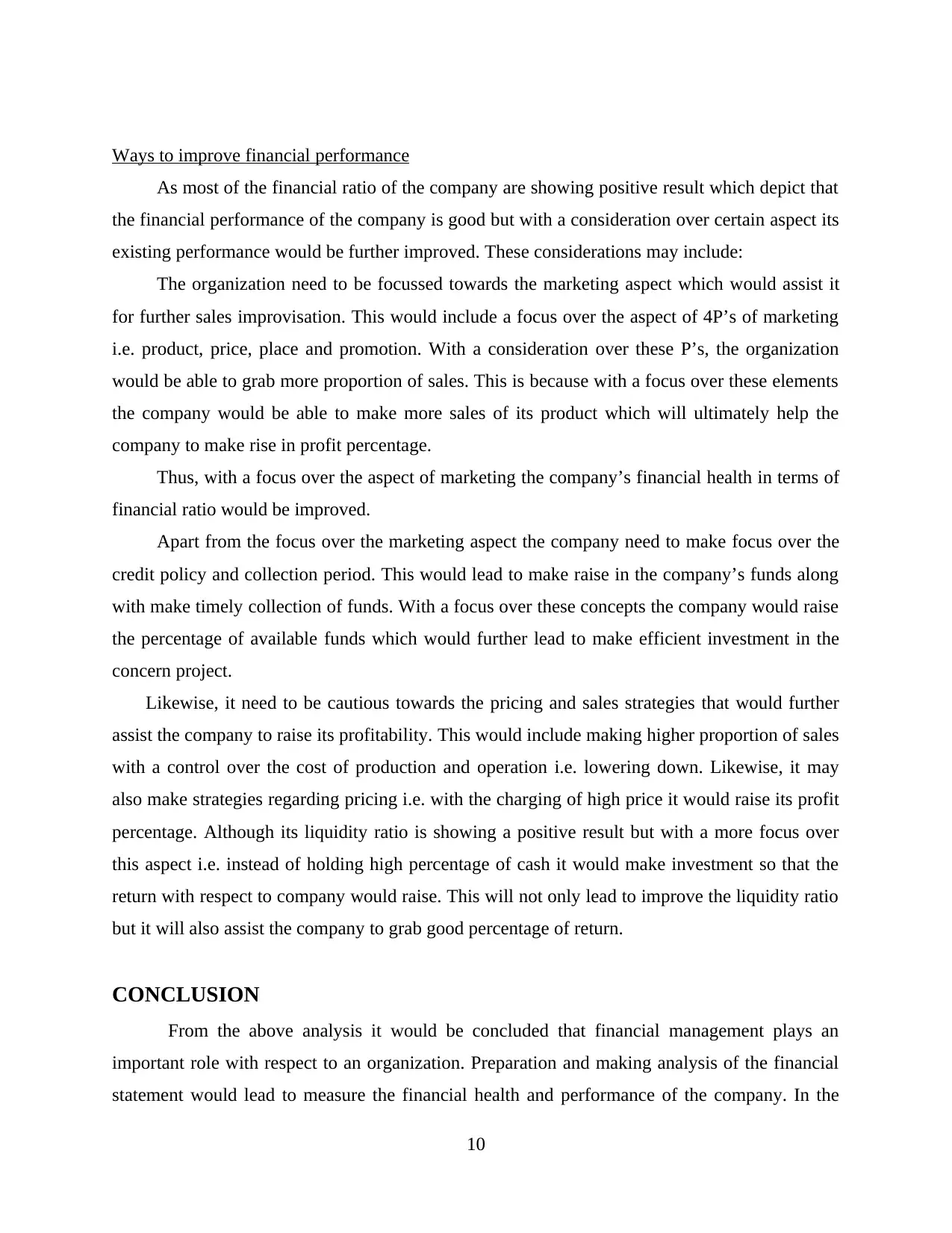
Ways to improve financial performance
As most of the financial ratio of the company are showing positive result which depict that
the financial performance of the company is good but with a consideration over certain aspect its
existing performance would be further improved. These considerations may include:
The organization need to be focussed towards the marketing aspect which would assist it
for further sales improvisation. This would include a focus over the aspect of 4P’s of marketing
i.e. product, price, place and promotion. With a consideration over these P’s, the organization
would be able to grab more proportion of sales. This is because with a focus over these elements
the company would be able to make more sales of its product which will ultimately help the
company to make rise in profit percentage.
Thus, with a focus over the aspect of marketing the company’s financial health in terms of
financial ratio would be improved.
Apart from the focus over the marketing aspect the company need to make focus over the
credit policy and collection period. This would lead to make raise in the company’s funds along
with make timely collection of funds. With a focus over these concepts the company would raise
the percentage of available funds which would further lead to make efficient investment in the
concern project.
Likewise, it need to be cautious towards the pricing and sales strategies that would further
assist the company to raise its profitability. This would include making higher proportion of sales
with a control over the cost of production and operation i.e. lowering down. Likewise, it may
also make strategies regarding pricing i.e. with the charging of high price it would raise its profit
percentage. Although its liquidity ratio is showing a positive result but with a more focus over
this aspect i.e. instead of holding high percentage of cash it would make investment so that the
return with respect to company would raise. This will not only lead to improve the liquidity ratio
but it will also assist the company to grab good percentage of return.
CONCLUSION
From the above analysis it would be concluded that financial management plays an
important role with respect to an organization. Preparation and making analysis of the financial
statement would lead to measure the financial health and performance of the company. In the
10
As most of the financial ratio of the company are showing positive result which depict that
the financial performance of the company is good but with a consideration over certain aspect its
existing performance would be further improved. These considerations may include:
The organization need to be focussed towards the marketing aspect which would assist it
for further sales improvisation. This would include a focus over the aspect of 4P’s of marketing
i.e. product, price, place and promotion. With a consideration over these P’s, the organization
would be able to grab more proportion of sales. This is because with a focus over these elements
the company would be able to make more sales of its product which will ultimately help the
company to make rise in profit percentage.
Thus, with a focus over the aspect of marketing the company’s financial health in terms of
financial ratio would be improved.
Apart from the focus over the marketing aspect the company need to make focus over the
credit policy and collection period. This would lead to make raise in the company’s funds along
with make timely collection of funds. With a focus over these concepts the company would raise
the percentage of available funds which would further lead to make efficient investment in the
concern project.
Likewise, it need to be cautious towards the pricing and sales strategies that would further
assist the company to raise its profitability. This would include making higher proportion of sales
with a control over the cost of production and operation i.e. lowering down. Likewise, it may
also make strategies regarding pricing i.e. with the charging of high price it would raise its profit
percentage. Although its liquidity ratio is showing a positive result but with a more focus over
this aspect i.e. instead of holding high percentage of cash it would make investment so that the
return with respect to company would raise. This will not only lead to improve the liquidity ratio
but it will also assist the company to grab good percentage of return.
CONCLUSION
From the above analysis it would be concluded that financial management plays an
important role with respect to an organization. Preparation and making analysis of the financial
statement would lead to measure the financial health and performance of the company. In the
10
Paraphrase This Document
Need a fresh take? Get an instant paraphrase of this document with our AI Paraphraser

same way it is also understood that an analysis of financial ratio would lead to assist the
company in analysing its performance along with taking suitable corrective action that would
lead to make further improvisation in its existing performance.
11
company in analysing its performance along with taking suitable corrective action that would
lead to make further improvisation in its existing performance.
11
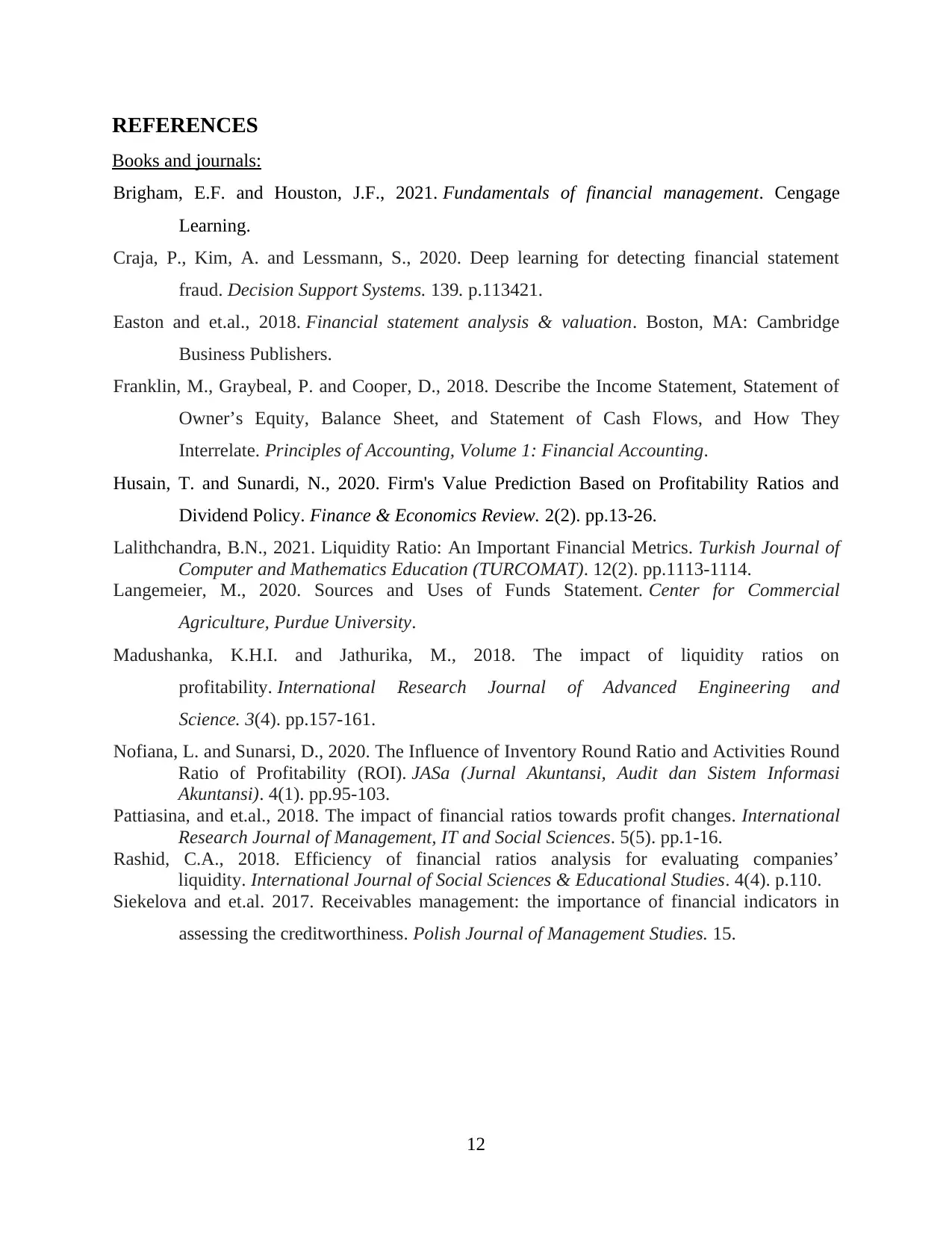
REFERENCES
Books and journals:
Brigham, E.F. and Houston, J.F., 2021. Fundamentals of financial management. Cengage
Learning.
Craja, P., Kim, A. and Lessmann, S., 2020. Deep learning for detecting financial statement
fraud. Decision Support Systems. 139. p.113421.
Easton and et.al., 2018. Financial statement analysis & valuation. Boston, MA: Cambridge
Business Publishers.
Franklin, M., Graybeal, P. and Cooper, D., 2018. Describe the Income Statement, Statement of
Owner’s Equity, Balance Sheet, and Statement of Cash Flows, and How They
Interrelate. Principles of Accounting, Volume 1: Financial Accounting.
Husain, T. and Sunardi, N., 2020. Firm's Value Prediction Based on Profitability Ratios and
Dividend Policy. Finance & Economics Review. 2(2). pp.13-26.
Lalithchandra, B.N., 2021. Liquidity Ratio: An Important Financial Metrics. Turkish Journal of
Computer and Mathematics Education (TURCOMAT). 12(2). pp.1113-1114.
Langemeier, M., 2020. Sources and Uses of Funds Statement. Center for Commercial
Agriculture, Purdue University.
Madushanka, K.H.I. and Jathurika, M., 2018. The impact of liquidity ratios on
profitability. International Research Journal of Advanced Engineering and
Science. 3(4). pp.157-161.
Nofiana, L. and Sunarsi, D., 2020. The Influence of Inventory Round Ratio and Activities Round
Ratio of Profitability (ROI). JASa (Jurnal Akuntansi, Audit dan Sistem Informasi
Akuntansi). 4(1). pp.95-103.
Pattiasina, and et.al., 2018. The impact of financial ratios towards profit changes. International
Research Journal of Management, IT and Social Sciences. 5(5). pp.1-16.
Rashid, C.A., 2018. Efficiency of financial ratios analysis for evaluating companies’
liquidity. International Journal of Social Sciences & Educational Studies. 4(4). p.110.
Siekelova and et.al. 2017. Receivables management: the importance of financial indicators in
assessing the creditworthiness. Polish Journal of Management Studies. 15.
12
Books and journals:
Brigham, E.F. and Houston, J.F., 2021. Fundamentals of financial management. Cengage
Learning.
Craja, P., Kim, A. and Lessmann, S., 2020. Deep learning for detecting financial statement
fraud. Decision Support Systems. 139. p.113421.
Easton and et.al., 2018. Financial statement analysis & valuation. Boston, MA: Cambridge
Business Publishers.
Franklin, M., Graybeal, P. and Cooper, D., 2018. Describe the Income Statement, Statement of
Owner’s Equity, Balance Sheet, and Statement of Cash Flows, and How They
Interrelate. Principles of Accounting, Volume 1: Financial Accounting.
Husain, T. and Sunardi, N., 2020. Firm's Value Prediction Based on Profitability Ratios and
Dividend Policy. Finance & Economics Review. 2(2). pp.13-26.
Lalithchandra, B.N., 2021. Liquidity Ratio: An Important Financial Metrics. Turkish Journal of
Computer and Mathematics Education (TURCOMAT). 12(2). pp.1113-1114.
Langemeier, M., 2020. Sources and Uses of Funds Statement. Center for Commercial
Agriculture, Purdue University.
Madushanka, K.H.I. and Jathurika, M., 2018. The impact of liquidity ratios on
profitability. International Research Journal of Advanced Engineering and
Science. 3(4). pp.157-161.
Nofiana, L. and Sunarsi, D., 2020. The Influence of Inventory Round Ratio and Activities Round
Ratio of Profitability (ROI). JASa (Jurnal Akuntansi, Audit dan Sistem Informasi
Akuntansi). 4(1). pp.95-103.
Pattiasina, and et.al., 2018. The impact of financial ratios towards profit changes. International
Research Journal of Management, IT and Social Sciences. 5(5). pp.1-16.
Rashid, C.A., 2018. Efficiency of financial ratios analysis for evaluating companies’
liquidity. International Journal of Social Sciences & Educational Studies. 4(4). p.110.
Siekelova and et.al. 2017. Receivables management: the importance of financial indicators in
assessing the creditworthiness. Polish Journal of Management Studies. 15.
12
⊘ This is a preview!⊘
Do you want full access?
Subscribe today to unlock all pages.

Trusted by 1+ million students worldwide
1 out of 14
Related Documents
Your All-in-One AI-Powered Toolkit for Academic Success.
+13062052269
info@desklib.com
Available 24*7 on WhatsApp / Email
![[object Object]](/_next/static/media/star-bottom.7253800d.svg)
Unlock your academic potential
Copyright © 2020–2025 A2Z Services. All Rights Reserved. Developed and managed by ZUCOL.




